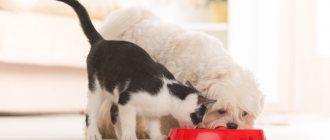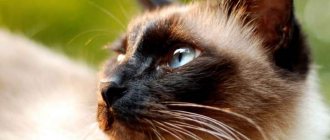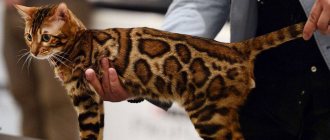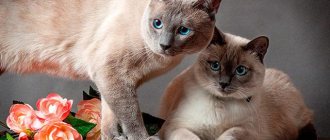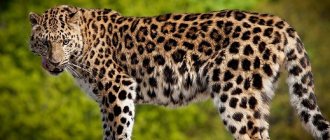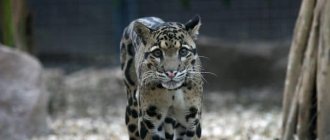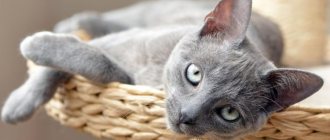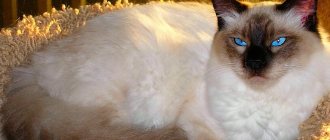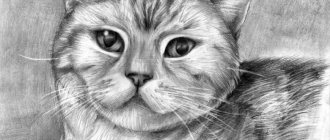The most popular hybrid spotted cat breeds
Most of these are animals obtained by crossing with wild cats.
Bengal
A hybrid of the Asian Leopard Cat or Lesser Leopard (ALC) and a domestic cat, bred by American breeder Jean Mill. Selection work began in 1961. Today the breed is recognized by all felinological systems of the world. The animal has been a pet since the fourth generation.
The first individuals were exclusively “golden” in color - there were black spots on a red background. With the development of the breed, pets of different colors were obtained:
- silver - the main background is silver;
- snow - in three modifications - linx, mink and sepia;
- marble - the spots merge into a large “cloak” or “sparble” pattern;
- charcoal - on a black background there are marks of the same color, while this is an experimental color.
Today, especially popular are individuals whose spots on the skin are arranged in the form of “rosettes”, reminiscent of the pattern of a jaguar’s fur. The most valuable pattern consists of three colors.
Even Bengals of the Siamese-Himalayan type have been bred. But no matter the color, the coat is the main distinguishing feature of this breed. It must have a “wild” pattern and is of the highest quality - short, without undercoat, tightly adjacent to the muscular body, glittery.
A kitten experiences phasing at two to five months, a process characteristic of wild cats. The bright pattern is hidden under the long secondary hair. The baby “blooms” to the age when his physical development allows him to protect himself from enemies and obtain food, in full accordance with natural canons.
Excessive hair loss occurs only during this period of time; in adult life, the Bengal cat does not shed.
This charming animal is rightfully called the “domestic leopard” due to its exceptional exotic coat pattern and energetic temperament.
Toyger
This is a “defective” Bengal, in which the standard prohibits the merging of spots into stripes.
The genetic fixation of this deficiency helped the emergence of a new breed. It was created by Judy Sugden, daughter of Jean Mill. Not all felinological systems have yet received recognition.
The colors of the Toyger are the same as those of the Bengal cat.
Savannah
The largest modern cat breed. It is a hybrid of Serval and Abyssinian. Registered by breeder Patrick Kelly in 2001 in the American felinological system TICA.
Savannah got the leopard coloring from a wild ancestor. Its color varieties are gold, silver, brown (ed), chocolate, cinnamon.
By nature, these cats are very curious and intelligent, easy to train. They do not tolerate loneliness well. Active, jumping and busy pets need a lot of space to play and love water very much.
Serengeti
A hybrid of Bengal and Oriental was created in California in 1994 by breeder Karen Sauzman. Due to its close resemblance to the Bengal cat, the breed is not widespread. Registered only in the American TICA system.
How much does a leopard kitten cost?
Bengal kittens cost from 30 to 100 thousand rubles, depending on the color and strength of the phenotype of a particular animal. Some sellers divide them into classes based on genetic strength.
Ashera prices start at $22,000. Royal ones cost $125,000 and appear no more than 4 times a year.
a Savannah kitten anywhere for less than $4,000.
The cost of the Serengetti is low due to the fact that the breed does not have a classical standard and strict requirements for the characteristics of animals. The average price is 35,000 rubles, which
The cost of a Kanaani kitten is from 90,000 rubles.
The price of the Arabian Mau starts at 40,000 rubles.
The most inexpensive among leopard cats is the Asian tabby. Its average price is $1,000.
The most popular spotted breeds of domestic cats
The tabby color is also found in breeds bred without crossing with wild cats.
Ocicat
In appearance it resembles the brightest cat in the world, Ocelot, and got its name in honor of him. Although it has no relationship with a wild cat, but was obtained by crossing a Siamese and Siamese-Abyssinian mestizos.
By its temperament, the Ocicat is a cheerful and playful pet, loyal and affectionate, sociable and loving.
The colors vary in color, but always with spots.
Egyptian Mau
Descended from common street cats of Cairo. Exported to America in the fifties of the last century. One of the oldest natural breeds in the world.
The color of the short, dense coat can be different - silver, bronze, smoky, pewter. But always a tabby - and only a dark spot.
A distinctive feature of his appearance is the “scarab” mark on his forehead and the black “eyeliner” of his expressive green eyes.
This small, muscular and very active cat has a balanced and independent character. She is attached to people, does not like loneliness, and is friends with all pets. Loves to talk with family members. The sounds that the Mau makes are not always like meowing, but resemble the “mumbling” of a person.
And you can learn more about this cat by reading the article about the Egyptian Mau on our portal.
Pixiebob
The Elf with the Short Tail was developed in the United States in 1985. The exact origin of the breed has not been determined; there is a version that wild cats participated in the selection, but this has not been confirmed by anything.
The pixie bob is characterized by the appearance of a lynx with tufted ears and a short tail. Polydactylism is common. The short or semi-long coat is always tabby in color - with spots or “rosettes”.
In their devotion to humans, these cats resemble dogs. Very calm, attentive and observant pets are friendly and love to play with children. They swim excellently, climb trees, hunt, “talk”, making beautiful curling and chirping sounds. They get along well with other pets, but are always leaders.
British Shorthair and Scottish Fold cats
The British and Scottish Fold are essentially different types of the same breed, although they are registered separately in feline systems. These are some of the most popular and oldest domestic breeds in the world.
By nature, these pets are self-sufficient, almost always phlegmatic. They like to sleep, but are not fans of active pastime. They are attached to people, love and do not offend children. Unpretentious and calm.
The colors of these cats are varied, spotted colors are very common.
American Shorthair (Kurzhaar)
This breed developed from its European relatives, who migrated with humans to America. A group of breeders began working on the approval of the variety at the beginning of the twentieth century.
The most famous color is the silver tabby - bright black, rather large spots on a light gray background.
The character of the American is called the “golden mean”, the cat is calm, does not require constant human attention, is moderately active and very devoted to the owner and all household members.
European Shorthair
The spotted color of this oldest breed is widely popular. The oldest European native variety was registered and presented to the public only in 1982.
A kind, energetic animal is deeply devoted to humans, willingly plays with children and at the same time never loses its hunting instincts.
Siberian
This natural oldest Russian breed most likely descended from Oriental cats brought to Siberia by merchants.
Animals with long hair and a thick undercoat are excellent hunters and have an independent and calm character. They are sincerely devoted to the owner and all household members, but do not like attention and affection imposed on them.
Among the many colors of Siberians, tabby is common.
Maine Coon
The raccoon cat is the pride of Americans. This natural breed has long been in the lead as the largest. The size of an adult cat (length with tail) reaches one and a half meters and weighs sixteen kilograms.
This pet is calm and undemanding, friendly and devoted to humans. But at the same time, like its ancient wild ancestor, it is an excellent hunter.
The colors of the coon are varied, spotted is quite popular.
Characteristics of tabby color
Coloring for the cat family is a convenient camouflage tool. In wild animals, it always corresponds to the area where they live, which greatly simplifies hunting.
In addition to direct color, the concept of color includes a unique pattern on the coat and the distribution of coloring pigment (melanin) on the hairs. The latter is divided into 2 types:
- eumelanin, which absorbs light rays and produces black color;
- pheomelanin, which reflects light rays and produces red color.
All other shades arise due to genes. They are responsible for the absence of pigment (white), brightness of color, zonal coloring of hairs (agouti) and direct pattern on the fur coat (tabby).
Description
Tabby is more than just spots. The pattern is created by zonal hair coloring and is divided into 4 types:
- Ticked, or Abyssinian. The tail, muzzle and paws are covered with residual stripes. There is no clear drawing.
- Marble. Characterized by the presence of rings on the tail, wide stripes on the chest, neck and shoulder blades. In the last two places the stripes take the form of a necklace and butterfly wings.
- Brindle. There is a continuous black stripe along the spinal column, and thin small stripes spread throughout the rest of the body. The tail is surrounded by dark rings.
- Spotted. The spots, randomly scattered throughout the body, have a strictly round shape, but different sizes. Elongated spots are found only on the tail and on the lower part of the legs. In these areas, merging into lanes is allowed.
IMPORTANT!
The more eumelanin, the worse the tabby is expressed. The pattern mainly appears in animals with a cream or red color.
Tabby affects the color of the nose and paw pads. It always matches the color of the spots.
Origin
Spotted color is characteristic of all wild cats. For this reason, many existing breeds are created by hybridization, that is, they are of artificial origin.
The spotted tabby gene is recessive. It is very difficult to achieve its manifestation, since almost everything suppresses it.
To obtain the desired color, breeders use individuals with the dominant agouti gene. It is responsible for zonal coloring of hairs, that is, for changing color saturation in different areas. When these genes are combined, the stripes and marbling are torn into individual elements, creating numerous spots throughout the body.
Interesting!
In addition to the agouti gene, there is also its opposite - non-agouti, a suppressive pattern. It is recessive and is activated in kittens only if inherited from 2 parents at once.
The rarest spotted cats
Leopard-colored cats are also among the new experimental breeds that have not yet found recognition.
Australian Smoke (Mist)
Breeder Labor Street from Sydney carried out enormous selection work, which involved simple and purebred cats - Abyssinian, Siamese, Burmese. Among the many colors, tabby is one of the most common.
Mist inherited excellent health from the barn cats, and extraordinary grace and dignity from the elite. Gets along well with any pet, is devoted to people, loves children, is active and energetic. Approved by a limited number of felinological organizations, it is not widely distributed.
California radiant
Despite its wild appearance, this is not a hybrid breed, but a mixture of many varieties of cats - British Shorthair, Manx, Siamese, Angora, Abyssinian.
Created by American screenwriter Paul Casey as a symbol of wild African cats, mercilessly destroyed by humans.
Very smart, friendly, silent and undemanding pets are still very rare and are registered only in the TICA felinological system (USA).
Toyger
The Toyger is a breed for those who would not mind having a tiger in their home. Representatives of this breed really resemble wild tigers, but in a mini version. They have a muscular body, brindle color, and short dense hair. However, their disposition is not at all predatory: they are very affectionate and friendly, like diligent pets. Translated, “toyger” means “toy tiger.”
Toygers are smart and highly trainable, and can be trained. They are sociable and playful and love to have fun. Find a common language with most people and animals.
They choose a master for themselves, to whom they are endlessly devoted. At the same time, the toyger is unpretentious and does not require increased attention to itself. Therefore, this breed is perfect for those who often leave the house.
Wild spotted cats - pets
Wild leopard cats are very beautiful. The fashion for keeping them at home has arisen more than once in the human community. But not all representatives of the cat world can be safely placed in a house.
Today, only three spotted species are most widespread as pets.
Serval
The African bush cat is a medium cat. Body length with a short tail is up to one and a half meters, weight - up to twenty kilograms. A small head, long legs and high-standing large ears make this animal look like a cheetah.
In order for a Serval to grow up tame, it must be taken away from its mother in the first days of life and fed by hand. Therefore, you should only purchase such a pet from experienced breeders.
A properly raised kitten will grow into a friendly cat, but its wild roots must not be forgotten. An adult must have a separate enclosure.
Food: raw meat only. During growing up, great attention should be paid to ensuring that there is enough calcium in the diet. Children have fragile limbs and fractures often occur.
The Serval's coloring is magnificent - dark spots on a reddish background.
Read more photos and interesting information about the serval in a separate article on Mister Cat.
Ocelot
A very bright animal, resembling a leopard in appearance, although smaller in size.
Less accommodating and less trainable than the Serval. An adult should only be kept in an enclosure. Nevertheless, it is often found today in home keeping because of the extraordinary beauty of its amazing colors. Such a pet named Babao lived with the famous artist Salvador Dali.
Geoffroy's cat
This small wild animal is similar in size to its domestic counterpart.
The brightly spotted skin was highly valued in the fur industry. Today this species is on the verge of extinction and is protected by the CITES Convention.
Therefore, it is now rarely found in home keeping, although it is popular. It is well tamed if at an early age the pet was taken from its mother and raised in the hands of a person. There are only a few breeders of this species, and it is difficult to acquire such a cat.
Ocicat
This breed does not have savages in its pedigree. Her ancestors are Siamese and Abyssinians, which were later crossed with American Shorthairs. The birthplace of the breed is the USA.
Externally, the animal resembles a wild ocelot, which is why the breed was given the name “Ocicat”.
The animal's fur is dotted with spots located on a plain base. The main background of the coat can be different - from blue to brown. The fur is short.
The Ocicat's head is medium in size, its muzzle is oblong. The ears are round and large. The eyes are expressive, almond-shaped. Their color can be any except blue.
By nature, Ocicats are extroverts. They are active, sociable, and love to have fun. They are able to find a common language with all family members, but they choose only one owner.
Standard colors
TICA (International Cat Association) divides all colors of Bengals into standard and non-standard. Both the first and second groups currently have three colors.
Brown
The most common color among Bengal cats. Its characteristics:
- Main background: from gray-brown to orange-golden. Bengals can be golden, cinnamon, cream, tan, caramel, honey, beige, taupe. All of these shades are allowed, but breeders still value the tan color.
- Spots, rosettes, marble pattern: black, dark brown, red-brown, light brown.
- Red nose.
- Green, copper, brown, golden eyes.
- Black tip of the tail.
- Preferably a white belly.
Photos of brown Bengal cats:
Snow
The color is given this name because the Bengal resembles a miniature snow leopard. The color of the coat varies from ivory to cream. Within this breed, snow colors are divided into three types.
Seal Lynx:
- Very light creamy, almost white coat color.
- A combination of warm and light spots, rosettes, and design elements.
- Dark brown tip of the tail.
- Always blue eyes.
Seal Lynx cats:
Seal Mink:
- Main color: ivory, cream, light brown.
- The pattern and spots are the color of seal skin (dark brown).
- Dark brown tip of the tail.
- Aquamarine, blue-green eyes.
Seal Mink cats:
Seal Sepia:
- Main color: ivory, cream, light brown.
- Pattern, stains: sepia or dark sepia.
- Dark tip of the tail.
- Golden or green eyes.
Seal Sepia cats:
Silver
This color excludes warm tones: a bright dark pattern on an almost white background. The suit can be described as follows:
- Main color: from white to dark steel.
- Lack of yellow, brownish, red tints.
- Spots, patterns: from dark gray to black.
- The tip of the tail is black.
- The nose is brick red.
- Eyes - gold or green.
Photos of silver bengals:
Serengeti
There are only a few hundred representatives of the Serengeti breed on the entire planet. Their homeland is America. The breed was developed not so long ago - in the 1990s. To create the Serengeti cats, matings were carried out between a Bengal cat and an Oriental shorthaired spotted cat.
Visually, the Serengeti is similar to the predatory servals, although they are not related. Its wild appearance combined with a non-aggressive character makes this cat surprisingly attractive.
The Serengeti has a medium-sized body that is athletic and athletic. Males are much larger than females. The tail is wide, its tip is black. The eyes of the Serengeti are large, widely spaced, and honey-colored.
Chausie - we bet you haven't heard of them
www.free-pet-wallpapers.com
Chausie breeders can be counted on one hand, which is a pity. Let's hope that someday the breed will leave its homeland, the USA, and become popular throughout the world.
Chausie cats make an unforgettable first impression - strength, power, grace, wild look and huge ears. At the same time, they cannot stand loneliness, can even make friends with a dog, have a melodic purr and almost never do any mischief. The color of the Chausie is not leopard, but due to its external resemblance to the lynx, they rightfully deserve a place on this list.
Gaming potential
A leopard-like cat is always ready to play and at any age. Innate intelligence helps Bengals learn funny and sometimes catastrophic techniques: •understand and carry out commands such as fu, come to me, here; •trained - bring slippers, catch and return the ball; • study and repeat the actions of the owners, as a result they are able to open and close door latches, taps, and flush the toilet repeatedly. The play potential should be taken into account when leaving pets alone at home, because after opening the water, the cat will not necessarily want to close the tap.
Bengal cat in the bath
Classification
Wild cats living in nature are not uncommon. These animals have many types and physical characteristics. However, there is something that unites them all.
Wild cats
All types of wild cats have common characteristics:
- maintaining a nocturnal or twilight lifestyle;
- living alone or with a family;
- camouflage color (depending on the habitat);
- most have the ability to retract their claws;
- the organs of vision, smell, and hearing are well developed.
It is customary to classify different types of cats according to a number of characteristics.
By size they are divided into three main subspecies:
- Large, hunting large prey. These include lions and tigers.
- Medium cats are cats that can catch both large and small prey.
- Marksman are representatives of the cat family whose weight does not exceed 18 kilograms. Small rodents and insects are caught for food.
Important! The division of animals into large and small, as a classification, is used extremely rarely, but still exists. For the most part, scientists prefer to classify the cat family by genera
Animals of the cat family, according to genetic data, are divided into 8 main categories, which are further divided into subcategories. These include:
- Panther genus. It is divided into clouded leopards and panthers.
- Genus of Kalimantan cats. These include marbled cats and catopums. The latter, it is worth noting that, since 2006, are also classified as marble.
- Caracal. This genus includes servals, golden cats and caracals themselves.
- Only tiger representatives are included in the ocelot genus.
- The lynx genus includes only lynxes.
- Cougars and cheetahs are part of the same lineage of pumas.
- Asian cats and Pallas cats are classified together; their genus is Bengal cats.
- Pets – all other domesticated breeds.
For the most part, modern cat species are divided according to their size. However, scientists have reduced the types to large and small sizes. The large subfamily includes:
- clouded leopards, including Kalimantan clouded and common;
- a lion;
- tiger;
- jaguar;
- snow leopard, snow leopard.
The list of representatives of small sizes includes:
- cheetah;
- caracal;
- African gold;
- Kalimantan cat;
- temminka;
- Chinese;
- jungle cat;
- dune;
- blackfoot;
- forest;
- Andean;
- Geoffrey;
- Chilean;
- long-tailed;
- oncilla;
- ocelot;
- bell;
- serval;
- lynxes of different varieties;
- manul;
- marble;
- Bengali;
- puma.
Range and habitats
Wild cats were popularized throughout central and western Europe. For some time they lived in southern countries - in Spain and Italy. Animals also lived in the territory of Asia Minor.
Today, forest cats can be found in the Caucasus and Ukraine. Also, animals invariably live in Europe. Forest cats surprisingly love to go to the mountains, to a height of 2-3 km above ground level. Central European cats have “settled” in the Caucasus since the times of the USSR.
Forest cats avoid almost all terrestrial predators, but wolves and foxes are the most dangerous for them. That's why cats prefer to go to the mountains or climb trees. They can stay in such a shelter for more than one month if they can get food for themselves.
What is the best name for a Bengal cat?
Experiment by taking turns calling the Bengal cat that first crossed the threshold of your home with different pre-prepared names, and watch her reaction: there is a chance that she will “choose” a nickname for herself. One way or another, hissing sounds are desirable as part of the name, to which your new animal is likely to react. It is highly desirable that the cat’s name begins with the same letter as its official, “passport” name. And, of course, you should not give a new friend the name of your former pet - this is considered a bad omen, especially if the previous pet disappeared or died of illness.
For charming Bengal girls, nicknames such as Lika, Fanta, Sheba, Astra, Stesha, Dosya, Lynx or even, for example, Skoda are perfect. Stately Bengal boys can proudly bear the name Alex, Onyx, Harley, Simba, Chester, Spotty and, of course, Leo - in honor of the wild bearer of a similar spotted coat.
Interesting Facts
- In ancient Egypt, when a cat died, all members of the owner's family shaved its eyebrows and mourned it. They buried the animal with honor, and during the procession they drank wine and beat their chests. The Egyptian Mau was embalmed and placed in a family tomb or animal cemetery with miniature mouse mummies.
- Toyger is the youngest breed of tiger cat. It was developed based on the requirements of modern life: the animal must become a friend and companion to the owner. So the toyger cat is a design development of breeders. By the way, they continue to be improved with the goal of making them completely similar in appearance to tigers.
- Wild oncilla is almost never kept at home. Only isolated cases of domestication of a predator are known, and their owners keep them not in houses, but in enclosures.
- Tiger cats, unlike many, can speak with their eyes. Their emotions and feelings are immediately imprinted in the expression of their muzzle, and it is quite difficult to distinguish one emotion from another, since they are caricatures.
- And finally, we want to give advice to those who want to have a tabby friend: under no circumstances let your cat go wild. These animals need constant displays of affection and love more than others. Otherwise, they will become withdrawn and even aggressive.
Sources
- https://givotniymir.ru/tigrovaya-koshka-opisanie-osobennosti-vidy-i-cena-tigrovoj-koshki/https://kot-i-koshka.ru/tigrovaya-koshka/https://koshkamurka.ru/ 5765-tigrovaya-koshka.htmlhttps://kotologia.com/porodyi/tigrovaya-koshka.htmlhttps://murlo.org/ru/porody-koshek-tigrovogo-i-leopardovogo-okrasa/https://pets2.me/ bok/412-oncilla-ekzoticheskiy-predstavitel-semeystva-koshachih.html
Features of caring for a Bengal cat
Since the Bengal kitty is short-haired, it requires less care than its shaggy counterparts. The animal is already accustomed to carefully licking its fur during fairly frequent sessions of “technical self-care.” So the owner can only brush the cat’s fur a couple of times a week using a soft rubber brush. The exception is the molting period, during which you can brush your pet more often.
Your cat's claws need to be trimmed about twice a month. The ears should be cleaned at the same frequency using a slightly moistened cotton pad. But it is recommended to brush your pet’s teeth much more often - once a week. Rare washing of the cat is also allowed. Special cat shampoos are designed for this. It is advisable to provide the Bengal with access to water, because the desire of these cats to frolic in it and fish is inherent in nature itself, so even an ordinary swim in a city bath will give the animal considerable pleasure: they can even take a shower with you.
pixabay.com/
